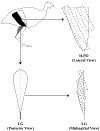American Society of Biomechanics Journal of Biomechanics Award 2017: High-acceleration training during growth increases optimal muscle fascicle lengths in an avian bipedal model
- PMID: 30266195
- PMCID: PMC6201240
- DOI: 10.1016/j.jbiomech.2018.09.001
American Society of Biomechanics Journal of Biomechanics Award 2017: High-acceleration training during growth increases optimal muscle fascicle lengths in an avian bipedal model
Abstract
Sprinters have been found to possess longer muscle fascicles than non-sprinters, which is thought to be beneficial for high-acceleration movements based on muscle force-length-velocity properties. However, it is unknown if their morphology is a result of genetics or training during growth. To explore the influence of training during growth, thirty guinea fowl (Numida meleagris) were split into exercise and sedentary groups. Exercise birds were housed in a large pen and underwent high-acceleration training during their growth period (age 4-14 weeks), while sedentary birds were housed in small pens to restrict movement. Morphological analyses (muscle mass, PCSA, optimal fascicle length, pennation angle) of a hip extensor muscle (ILPO) and plantarflexor muscle (LG), which differ in architecture and function during running, were performed post-mortem. Muscle mass for both ILPO and LG was not different between the two groups. Exercise birds were found to have ∼12% and ∼14% longer optimal fascicle lengths in ILPO and LG, respectively, than the sedentary group despite having ∼3% shorter limbs. From this study we can conclude that optimal fascicle lengths can increase as a result of high-acceleration training during growth. This increase in optimal fascicle length appears to occur irrespective of muscle architecture and in the absence of a change in muscle mass. Our findings suggest high-acceleration training during growth results in muscles that prioritize adaptations for lower strain and shortening velocity over isometric strength. Thus, the adaptations observed suggest these muscles produce higher force during dynamic contractions, which is beneficial for movements requiring large power outputs.
Keywords: Acceleration; Fascicle length; Guinea fowl; Ontogeny; Training.
Copyright © 2018 Elsevier Ltd. All rights reserved.
Conflict of interest statement
CONFLICT OF INTEREST
The authors declare no conflicts of interest.
Figures





Similar articles
-
Function of a large biarticular hip and knee extensor during walking and running in guinea fowl (Numida meleagris).J Exp Biol. 2011 Oct 15;214(Pt 20):3405-13. doi: 10.1242/jeb.060335. J Exp Biol. 2011. PMID: 21957104 Free PMC article.
-
Mechanics of feline soleus: I. Effect of fascicle length and velocity on force output.J Muscle Res Cell Motil. 1996 Apr;17(2):207-19. doi: 10.1007/BF00124243. J Muscle Res Cell Motil. 1996. PMID: 8793723
-
Muscle force-length dynamics during level versus incline locomotion: a comparison of in vivo performance of two guinea fowl ankle extensors.J Exp Biol. 2003 Sep;206(Pt 17):2941-58. doi: 10.1242/jeb.00503. J Exp Biol. 2003. PMID: 12878663
-
Scaling of avian bipedal locomotion reveals independent effects of body mass and leg posture on gait.J Exp Biol. 2018 May 22;221(Pt 10):jeb152538. doi: 10.1242/jeb.152538. J Exp Biol. 2018. PMID: 29789347 Review.
-
The influence of longitudinal muscle fascicle growth on mechanical function.J Appl Physiol (1985). 2022 Jul 1;133(1):87-103. doi: 10.1152/japplphysiol.00114.2022. Epub 2022 May 19. J Appl Physiol (1985). 2022. PMID: 35608202 Review.
Cited by
-
Gastrocnemius fascicles are shorter and more pennate throughout the first month following acute Achilles tendon rupture.PeerJ. 2019 Apr 23;7:e6788. doi: 10.7717/peerj.6788. eCollection 2019. PeerJ. 2019. PMID: 31065459 Free PMC article.
-
Eliminating high-intensity activity during growth reduces mechanical power capacity but not submaximal metabolic cost in a bipedal animal model.J Appl Physiol (1985). 2020 Jan 1;128(1):50-58. doi: 10.1152/japplphysiol.00679.2019. Epub 2019 Nov 21. J Appl Physiol (1985). 2020. PMID: 31751181 Free PMC article.
-
The evolution of human fatigue resistance.J Comp Physiol B. 2022 Jul;192(3-4):411-422. doi: 10.1007/s00360-022-01439-4. Epub 2022 May 12. J Comp Physiol B. 2022. PMID: 35552490 Free PMC article. Review.
-
Plasticity of the gastrocnemius elastic system in response to decreased work and power demand during growth.J Exp Biol. 2021 Nov 1;224(21):jeb242694. doi: 10.1242/jeb.242694. Epub 2021 Nov 10. J Exp Biol. 2021. PMID: 34522962 Free PMC article.
-
Muscle structure governs joint function: linking natural variation in medial gastrocnemius structure with isokinetic plantar flexor function.Biol Open. 2019 Dec 16;8(12):bio048520. doi: 10.1242/bio.048520. Biol Open. 2019. PMID: 31784422 Free PMC article.
References
-
- Abe T, Fukashiro S, Harada Y, Kawamoto K, 2001. Relationship between sprint performance and muscle fascicle length in female sprinters. Journal of Physiological Anthropology and Applied Human Science 20, 141–147. - PubMed
-
- Abe T, Kumagai K, Brechue WF, 2000. Fascicle length of leg muscles is greater in sprinters than distance runners. Medicine and Science in Sports and Exercise 32, 1125–1129. - PubMed
Publication types
MeSH terms
Grants and funding
LinkOut - more resources
Full Text Sources
Other Literature Sources

